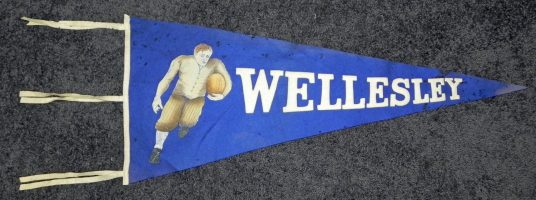Wellesley College
Massachusetts
1870




Until his death in 1921, Gardner Cotrell Leonard was the Director of the Intercollegiate Bureau of Academic Costume (IBAC) and a partner in the firm of Cotrell & Leonard, an academic costume manufacturer and the depository for the records of the IBAC. In May 1893 Mr. Leonard wrote “The Cap and Gown in America” for The University Magazine where he stated that Wellesley College was a client of Cotrell & Leonard. Two years later the Intercollegiate Code of Academic Costume came into force, which stipulated that an academic hood lining would now display the colors of the institution that conferred the degree. If one assumes that a college or university was assigned a new hood lining pattern by the IBAC when academic costume was ordered from Cotrell & Leonard, client lists for Cotrell & Leonard can help one estimate the approximate date that lining pattern was approved by the IBAC.
Wellesley College suddenly appeared in Cotrell & Leonard advertisements in four 1896-97 sources: the second volume of a photographic album entitled Souvenir of the University of Michigan (1896), the 1897 Bowdoin Bugle yearbook, The College Year-Book and Athletic Record (1897), and the 1897 “Ole Miss” of The University of Mississippi yearbook, which suggests an IBAC hood assignment for the college between 1895 and 1897.

The blue adopted by the founder of Wellesley in 1870 has varied over the years but typically has been a medium to dark shade of blue. Editions of the World Almanac from the early 1900s described it as either blue, deep blue, or dark blue, whereas the Wellesley Alumnae Quarterly Vol.2 No. 1 (October 1917) described Wellesley’s blue as “the color of Lake Waban on its blue days” (p.2). Unhelpfully, other historical sources describe the shade of Wellesley’s blue as “Wellesley blue”.
Citations in the World Almanac (listed by cover date; color information is from the previous year): blue (1895-1900); deep blue (1902-1916); dark blue (1917-1918); deep blue (1923-1931); blue (1934-1935)

These advertisements did not describe the color or heraldic pattern of Wellesley’s hood lining, but the college’s hood was cited in the 27 July 1902 edition of The Argus, an Albany NY newspaper, which contained a list of IBAC hood lining patterns that had been assigned to some of the more prestigious colleges and universities of the time. Wellesley must have sent the Bureau a color sample that was on the deeper end of the college’s range of blues, because in The Argus Wellesley’s hood lining was described as “dark blue”, unfortunately creating a duplication with the dark blue lined hood Yale had chosen for itself in 1895. By the middle of the 1920s the IBAC was describing Wellesley’s hood lining as “Wellesley blue” – like “Yale blue” a synonym the Bureau often used for “dark blue”. Non-IBAC hood lists from the 1960s and 70s stated that Wellesley’s hood lining was “Yale blue” in color with a white chevron – something the IBAC must have added to Wellesley’s hood by 1972 to distinguish the college’s hood lining from that of Yale’s. Unfortunately the added white chevron caused the college’s new hood to duplicate the hood lining of Pennsylvania State University (navy blue with a white chevron) the IBAC had assigned by 1918 at the latest.
To resolve these problems, Wellesley has now been reassigned a single color hood lining in a medium blue hue that is historically consistent with the one of the shades of blue the college has used since the late 1800s.